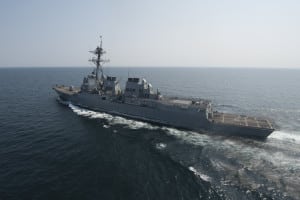The Navy may reverse itself again and re-institute a class-wide service life extension of DDG-51 Arleigh Burke-class destroyers if it gets the funding, the Navy’s top procurement official told a congressional panel Thursday.
In written testimony to a Senate Armed Services Seapower subcommittee hearing last week, Navy officials said after evaluating the best balance between costs and capability, it was removing a plan dating back to 2018 to institute service life extensions on the entire Arleigh Burke-class DDG-51 destroyers to reach a 355-ship fleet faster (Defense Daily, March 11).

Speaking before the House Armed Services Readiness Subcommittee March 12, Assistant Secretary of the Navy for Research, Development and Acquisition James Geurts explained this change was due to funding limitations but will only impact decisions starting in FY 2026.
Subcommittee Ranking Member Doug Lamborn (R-Colo.) noted this change will reduce the Navy’s size by 27 destroyers between FY 2026-2034 compared to the class-wide extension plan.
“What is the business case for this decision,” Lamborn asked Geurts.
“To put it in perspective, what we’re talking about is post-FYDP changes,” he said. “So none of these would be until the 2026-30 area. So that was one of the reasons it didn’t get communicated clearly given the shipbuilding plan.”
In 2018, the Navy first told Congress it found the entire DDG-51 class could have its service life extended so each ship would last for 45 operational years and then the Navy would reach 355 ships by the 2030s (Defense Daily, April 13, 2018 ).
Then-Deputy Chief of Naval Operations for Warfare Systems Vice Adm. William Merz told the HASC Seapower subcommittee extending the entire class means “then we can roll in the right maintenance and modernizations much more efficiently, much more affordably for the entire duration of the class.”
On Thursday, Geurts told the subcommittee “what this shows you is some of the stark choices the Navy’s having to make with a relatively flatline [budget].”
“Service life extensions do add to the size of the fleet but they kind of just push the cliff to the right and so we’ve got to be cautious – you don’t keep extending forever without building because eventually you will run out of an ability to extend and so it reflected some hard choices we had to make in long term planning,” Geurts continued.
However, the Navy’s top acquisition official noted this decision only impacts actions in FY 2026 and later, but the Navy will continue to look at the best business case analysis.
“My guess as we go closer to that – we made some pretty big swings from 35- to 45-year service lives for our oldest destroyers. I think we’ll look at those in a little bit more micro detail as we get closer to make sure the business case is there.”
Using cruisers as an example, Geurts warned there is a point where the cost of extending older ships is not worth the benefit “particularly if we don’t have the ship maintenance enterprise working at full efficiency.”
However, he said as the Navy increases ship maintenance effectiveness and efficiency “that may allow us to extend those ships without breaking the budget.”